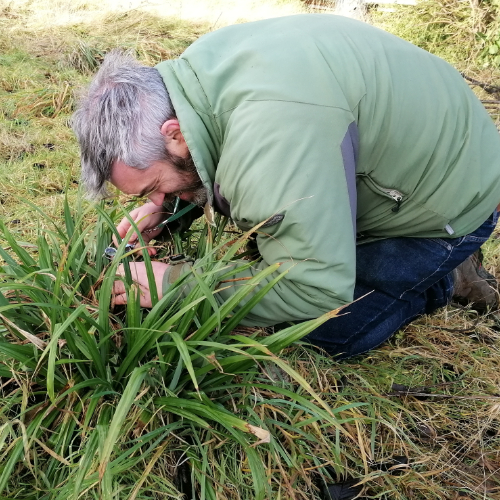Study online to gain practical skills and confidence in identifying sedge (Cyperaceae family) species using a standard botanical key.
 Course overview
Course overview
This online course is for ecological consultants, land managers, conservationists and all beginner/improving botanists. You will:
- Upskill before the start of the field season, studying at a time and pace that suits you.
- Become comfortable with sedge terminology and confident keying Carex and other sedges in a standard key.
- Become familiar with 16 common sedge species and know how to distinguish them from similar species.
- Recognise vegetative characteristics as well as the flower/fruit details used for keying.
- Learn about sedge habitats.
- Pick up fieldcraft tips for finding and identifying sedges and their habitats.
- Have support by email, videocall and live tutorials from an experienced teacher.
- Earn a certificate to prove your skill.
Course details
This course is fully online, using a learning model tried and tested with undergraduates, MSc students and conservation volunteers. Expect to spend about 20 hours of study time.
Lectures introduce the concepts and terminology you need to understand and use botanical keys. These are recorded so you can listen at the time that suits you and can pause, speed up or slow down the recording to take notes.
Once you have keyed out a sedge you will enter the specimen number into an online quiz to check if you are right. If you’ve made a common error, a hint will point you in the right direction but if you’re correct you’ll see fascinating facts about that species in the question feedback. In this course as in the field, identifying a species is the first step to unlocking a world of information about its ecology, biology and conservation.
Test your new knowledge with a practice quiz which shows you different photos of the species you have studied to see if you can recognise them.
Online group tutorials and email/video call support from the course tutor will guide you if you get stuck and give the opportunity for real live botany chat.
Start date
This course is open for enrolment now and can be studied at your own pace. After registration, the course material is delivered through our online learning platform at https://moodlecommunity.napier.ac.uk. You must first register to get access by using the 'Buy Now' link below.
Assessments
The course is assessed by an online test which asks you to recognise or key out sedge specimens and identify them correctly. Certificates are issued for successful completion.
Entry requirements
The course is suitable for anyone with an interest in identifying plants.
Fees
The course fee is £100 +VAT. Students and Edinburgh Napier graduates are eligible for a discount, making the course fee £70 +VAT. Please email J.mackinnon@napier.ac.uk with evidence of student/graduate status to get a discount code.
What past participants have told us...
"Lectures were really excellent and very thorough. The photographs of all the specimens for were of high quality and were very thorough and well thought out. They form a really good reference source for sedge identification. A super course."
"Wonderful photos of the detail of the plants. Really clear explanation of the anatomy in the lectures which helped me use the key."
"The materials for this course really were exceptional. I have always been a bit daunted by sedges but this course has given me confidence to get started. The level was perfect: not too basic for someone experienced in other areas of botany but not overwhelming either."